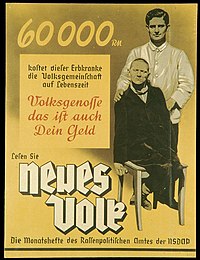Life unworthy of life

| Part of Auschwitz , May 1944 |
The phrase "life unworthy of life" (
The "euthanasia" program was officially adopted in 1939 and came through the personal decision of
Historians estimate that 200,000 to 300,000 people were murdered under this program in Germany and occupied Europe.[6][7][8][a]
History
The expression first appeared in print via the title of a 1920 book, Die Freigabe der Vernichtung Lebensunwerten Lebens (Allowing the Destruction of Life Unworthy of Life) by two professors, the jurist
The concept culminated in
Development of the concept
According to the author of Medical Killing and the Psychology of Genocide psychiatrist Robert Jay Lifton, the policy went through a number of iterations and modifications:
Of the five identifiable steps by which the Nazis carried out the principle of "life unworthy of life,"
See also
- Aktion T4
- Nazi concentration camp badges
- Holocaust victims
- Department of Film (Nazi Germany)
- Useless eaters
- Nazi eugenics
- Nazism and race
- Sagamihara stabbings
- Social cleansing
- Am Spiegelgrund clinic
References
- ^ a b Lifton, Robert Jay (23 July 2005). "The Nazi Doctors: Medical Killing and the Psychology of Genocide". holocaust-history.org. Archived from the original on 12 November 2020. Retrieved 23 August 2021.
- ^ Ley, Astrid (2021). "Euthanasie" und Holocaust. Brill Schöningh. pp. 195–210. Retrieved 31 October 2023.
- .
- ISBN 9780807846759.
- ISBN 1566635659.
- ^ "Exhibition catalogue in German and English" (PDF). Berlin, Germany: Memorial for the Victims of National Socialist ›Euthanasia‹ Killings. 2018.
- ^ "Euthanasia Program" (PDF). Yad Vashem. 2018.
- ^ a b Chase, Jefferson (26 January 2017). "Remembering the 'forgotten victims' of Nazi 'euthanasia' murders". Deutsche Welle.
- ^ Cover of Die Freigabe der Vernichtung Lebensunwerten Lebens (Allowing the Destruction of Life Unworthy of Life) at German Wikipedia.
- ^ Dr S D Stein, "Life Unworthy of Life" and other Medical Killing Programmes. UWE Faculty of Humanities, Languages, and Social Science – via Internet Archive.
- ^ from the original on 4 August 2009. Retrieved 23 August 2021.
Notes
- ^ As many as 100,000 people may have been killed directly as part of Aktion T-4. Mass euthanasia killings were also carried out in the Eastern European countries and territories Nazi Germany conquered during the war. Categories are fluid and no definitive figure can be assigned but historians put the total number of victims at around 300,000.[8]
External links
- "Life Unworthy of Life" and other Medical Killing Programmes by Dr. Stuart D. Stein, University of the West of England
- Contemporary English translation of "Allowing the Destruction of Life Unworthy of life" by Dr. Cristina Modak
- German text online of Die Freigabe der Vernichtung Lebensunwerten Lebens
